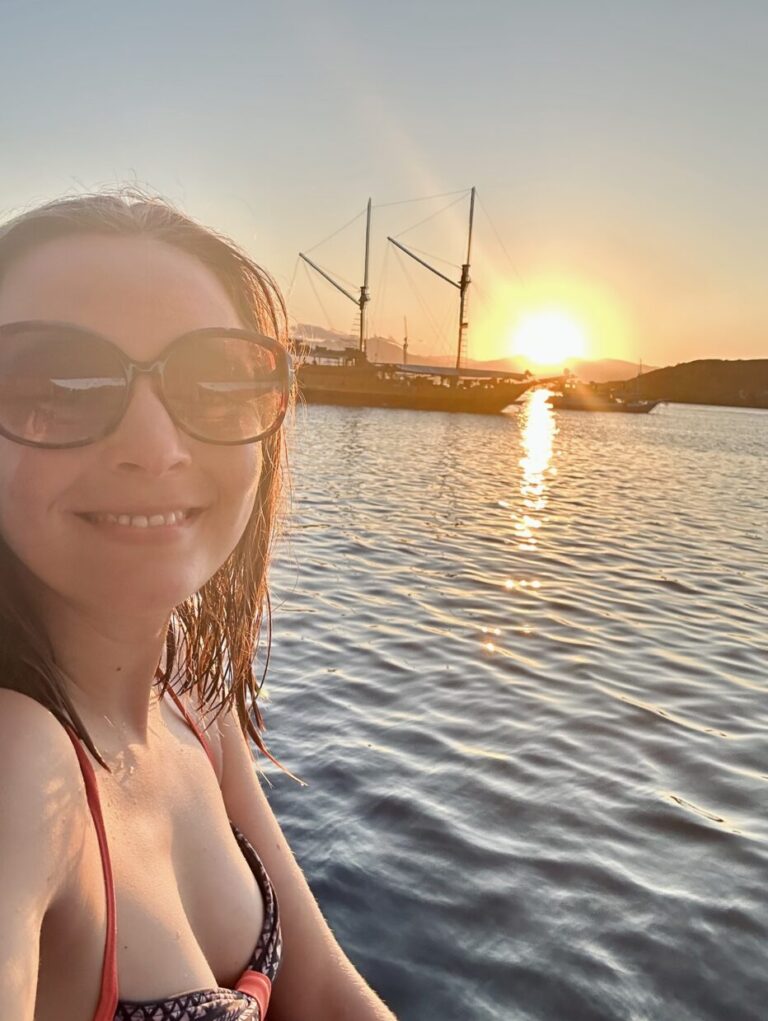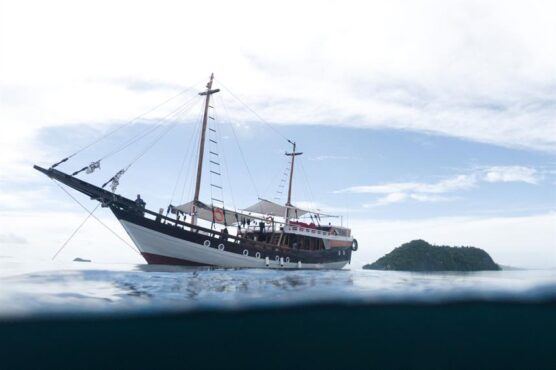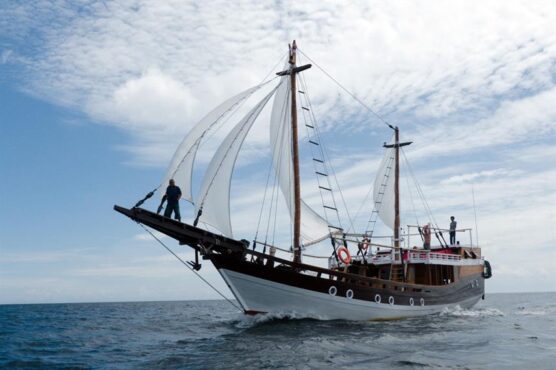
Happy Days on the Akomo Isseki: Captain Jas Review
Hello, I’m Jas from Germany. During my travels through Indonesia in September 2023, I received orders for a special mission from the Grand Admiral of the diving squad himself.
At that time, I was located on Nusa Penida, close to Bali. The orders were to investigate and observe; an interesting object caught our attention: The Akomo Isseki, a liveaboard operating in both the Komodo National Park and Raja Ampat, depending on the season.
I decided to spend 8 days/7 nights on the Akomo Isseki to explore the wonders of the waters around Komodo National Park. Find out more about my experience:

Captain Jas
Planning and preparing for the liveaboard
As with any journey, planning and preparation are helpful for a smooth operation during a liveaboard. I booked my stay on very short notice, just 7 days before the start date.
Fortunately, I was lucky to secure a spot for a female guest in a double room on such short notice. The Akomo Isseki is often fully booked months in advance, so I recommend booking early.
After my booking, I received the WhatsApp number of the boat operator directly: an Englishman named Richard. I sent him a brief message to clarify the remaining details for the start. He was very kind and helpful, providing me with the exact meeting point at the port.
Additionally, I received a PDF document with a detailed description of the itinerary. This description is more of a rough guideline, as the actual itinerary can be adjusted last-minute depending on weather conditions and the need to dodge larger dive groups.
In addition to booking and travel, I prepared for the trip by considering how and what to pack most efficiently.
At that time, I was traveling with my two backpacks and was initially unsure whether to bring both on board or leave one on land. A quick inquiry via WhatsApp with the liveaboard team revealed that the cabins offer enough space for typical backpacker luggage, so I was good to go.
Review of the boat itself: The Akomo Isseki

The Akomo Isseki is a beautiful Indonesian Phinisi crafted from tropical hardwood, specifically built in Bira, Sulawesi — the “capital” of Phinisi craftsmanship in Indonesia.
Indonesian Phinisis have been navigating the Southeast Asian archipelago since the 14th century. The name of the boat comes from the Konjo language in Sulawesi and is a little joke. When asked about the meaning of Akomo Isseki, the Sulawesians reply with a sly smile, saying: “You don’t need to know.”
Layout of the boat
The intelligently designed levels and windows of the boat ensure good ventilation, although the boat does not have air conditioning. Additionally, parts of the boat are covered with solar panels, providing sustainable power for the outlets.
Equipment and boarding area
Boarding takes place at the rear of the ship, where the small speedboat is usually secured. This area serves as storage for all diving equipment, making it very convenient to avoid unnecessary carrying. Here, you’ll find hooks for wetsuits, freshwater containers for rinsing cameras and other equipment after diving.
Each pair of guests shares a box for storing smaller diving equipment: cameras, masks, snorkels, etc. The area also houses the compressor for filling tanks, secluded enough to not disturb other areas of the ship with the humming sound. This area is well-organized, efficent and tidy.
Sundeck of the Akomo Isseki
The sundeck is the highlight of the Akomo Isseki — it is the place where we spent most of our time. There are 8 large beanbags, perfect for all kinds of decompression activities after diving: chilling, chatting, napping, tanning, reading or logging.
Parts of the deck are always in the shade thanks to the sun awning. On the sundeck, we enjoyed watching the sunrise in the morning & the sunset in the evening.
Cabins of the liveaboard
The Akomo Isseki can accommodate up to 8 guests in 4 cabins, each designed for 2 people with small wall closets and larger storage space under the bed. The cabins do not have air conditioning or power outlets.
Ventilation is provided through a skylight that opens towards the deck. Thanks to the sea breeze, I found the sleeping temperature in the cabins pleasant, and I could sleep well even without air conditioning.
Bathrooms
There are 2 bathrooms on board, shared by all. Both combine a toilet, sink, and shower and are kept very simple. During my stay, the freshwater for the shower went out twice for a few hours, but it didn’t detract from my experience.
Kitchen on board
Following the stairs from the rear, you’ll reach the kitchen area. It is set up like a small, smart bar. You can watch Dierman and Bob cook, or grab some vinegar if you happen to get stung by a stingy coral. Which happened to me twice.
Dining area
From the kitchen, additional stairs lead to the lounge/dining area, which includes a spacious wooden table and bench. When building the Phinisi, the clever Sulawesians took the largest Indonesian they could find to simulate the size of Europeans.
Unfortunately, it didn’t quite work out, and the ceiling is so low that anyone over 1.70 m might easily bump their head. The dining area also features a water dispenser, a cookie jar, hot water for tea and coffee, and a power strip for charging all electronic devices.
Delicious Indonesian Food on the Akomo Isseki
The Akomo Isseki provides three-and-a-half meals per day: breakfast, lunch, afternoon snack, and dinner. The timing of meals is aligned to the dive schedule, with a meal or a small snack provided after each dive. For breakfast, there was always a selection of fresh fruits such as pineapple, dragon fruit, papaya, melons, apples, or bananas.
Additionally, there were eggs, pancakes, bread, spreads, and rice (don’t ask me why). Lunch and dinner featured warm dishes, always including rice, noodles, vegetables, and usually a vegetarian sauce alongside one with either fish or meat. All guests expressed positive remarks about the flavor variety and the loving preparation of the dishes.
Diving Experience
Schedule for diving days on the Akomo Isseki
The diving agenda aboard the Akomo Isseki includes three dives per day. There was one exception: one day we did a fourth dive: a night dive. Although the dives were not scheduled at the exact same hour every day, a general rule of thumb was followed: 8 AM, 11 AM, 2:30 PM.
Each evening, we discussed the schedule for the next day. When planning, the guides considered various factors such as weather conditions, visibility, currents (particularly important around Komodo), as well as the presence of other boats and dive groups. A half-hour before each dive, a comprehensive dive briefing took place.
The 8 guests were divided into two dive groups with one guide each. I appreciated the small group size very much, especially with the currents in Komodo I felt safe knowing that the guide was close and could focus on the four of us.
- Big speaker for playing music
- Guitar + Cajon (not sure if these are permanently on board)
- tea / coffee + cookies
- Charging station in the dining area
- 2 kayaks
- Unfortunately, no games or cards: I recommend bringing some 🙂
Dive Briefings
The dive briefings on the Akomo Isseki were by far the best I have ever received. Each briefing included a hand-drawn sketch of the topography of the dive site. Not only were rock formations marked, but also entry and exit points, depths, and anticipated currents.
The guides thoroughly explained each dive site – an absolute necessity for Komodo, as the entire area is notorious for strong currents. We regularly reviewed and practiced safety communications: safety stops, air signals, deployment and timing of reef hooks. Each briefing also included a description of the marine life expected at the dive site.
I found the briefings entertaining and informative – the perfect blend of fun and knowledge. It was evident that the guides had a passion for diving and knew the area very well. Overall, the high-quality dive briefings significantly contributed to my overall positive diving experience on the Akomo Isseki.
All dive sites on my 8D/7N Komodo Liveaboard Stay on the Akomo Isseki
To describe all the dive sites during the 8-day diving safari through Komodo National Park would exceed the scope of this report. Therefore, here’s a brief overview: All dive sites in Komodo National Park are incredibly beautiful and host a vast diversity of flora and fauna, while providing awesome visibility.
From stunning and healthy reefs adorned with hard and soft corals to a myriad of marine life, including seahorses, Nudibranchs, massive schools of fish, tuna, turtles, sharks, and last but not least, manta rays. Additionally, the underwater topography offers an insane variety, ranging from gently sloping reefs to steep cliffs and overhangs with small caves.
The currents also contribute to the diving experience in Komodo, with places like the legendary dive site ‘The Cauldron’, aka Shotgun, providing a thrilling underwater rollercoaster ride with an adrenaline kick, casually accompanied by multiple Manta Rays.
Tatawa Kecil boasts the most stunning reef I have ever seen. It’s as densely populated as a beehive, with an infinite number of beautiful, colorful reef fish. At Turtle Point, I encountered so many turtles that I lost count. Here is a list of all dive sites we explored during my Komodo trip with the Akomo Isseki:
- Sabolan Besar
- Sabolan Kecil
- Sebayur Wall
- Sebayur Kecil
- Shotgun / The Cauldron
- Crystal Rock
- Castle Rock
- Shotgun / The Cauldron
- Tatawar Besar
- Siaba Besar
- Turtle Point
- Gindang
- Nightdive at Gindang
- Police Corner
- Manta Point
- Tatawa Kecil
- Batu Balong
- Manta Point
- Mawan
Rental diving equipment on the Akomo Isseki
I rented all my equipment on board the Akomo Isseki, and I was extremely satisfied with every piece. My guide advised me on a well-fitting mask, my 3mm long-sleeve wetsuit was in excellent condition, and all technical components such as BCD, regulators, tanks, flashlights, and reef hooks were in outstanding condition, making me feel very secure. I paid 2.900.000 IDR for a full set of diving gear for the 8 days in Komodo.
While on board, I had the opportunity to observe the crew professionally cleaning the tanks, which was super interesting and reassuring to see that equipment maintenance is taken seriously and done professionally.
Social life on the Liveaboard
The guests on the Akomo Isseki
From a social perspective, I felt very comfortable on board the Akomo Isseki. We were a total of 8 guests: a couple on their honeymoon and 6 solo travelers – 3 women and 5 men.
The group was a diverse mix, with 4 guests from Germany, 2 from France, and one each from the USA and Australia. Except for one exception, everyone was between 26 and 35 years old, creating a wonderful group dynamic and a sense of togetherness.
Lots of Love: the amazing Crew of Akomo Isseki
I can hardly find words that would do the amazing crew of the Akomo Isseki justice. Other than the 2 dive guides, we had a large crew taking care of the boat, equipment, and meals. Most of them were locals from Sulawesi. Despite the language barrier with many crew members, I felt extremely comfortable and in safe hands.
The crew really made the boat feel like a home for that one week I spent on it. It was a mix of little small gestures: Before each dive, they not only assisted us attentively with the equipment but also bid us farewell warmly, waving and joking around. Their enthusiasm and positive energy were infectious. I cannot express my gratitude for this experience enough.
Diversified adventures: Non-Diving Activities on Akomo Isseki
On such journeys, engaging in additional activities adds depth to the overall experience, providing a chance to explore beyond diving and get to know fellow guests. Life on the boat naturally fosters good exchanges among guests, providing ample topics for discussion: the food, the next briefing, reflections on the recent dives, or shared diving experiences. Simultaneously, after diving, we all needed some quiet and relaxation time, and the chill-out sessions on the sundeck were much needed for unwinding.
Nevertheless, I found the additional activities to be a pleasant balance, by no means too strenuous. Moreover, they were optional, allowing anyone to retreat at any time. Here are some activities we undertook:
Hike on the secluded island of Gili Lawa Darat: I was initially disappointed as we didn’t visit the famous Padar Island. Instead, we spent some time on Lawa Darat, hiking through a beautiful landscape. Unlike Padar, which was overrun with tourists, the hike on Lawa Darat was not crowded at all and we had several viewpoint completely for ourselves.
Kayaking in the mangroves: Anchored near Siaba Besar, we had the opportunity for a kayaking tour. The island’s shoreline is adorned with a mangrove forest emerging from the clear blue water. With 2 kayaks on the Akomo Isseki, we ventured in pairs, paddling along the outskirts. While I didn’t spot any extraordinary wildlife, the paddling itself was fun.
Beach Party: One evening, we left the Akomo Isseki with our beloved beanbags and drinks to spend the night on the beach. We had the entire beach (and the island it was on) to ourselves, complete with a volleyball and music.
On-board Entertainment: All guests thoroughly enjoyed the conversations with our dive guides. The two Indonesians were incredibly friendly and open. Many evenings, one of them played the guitar for us. Additionally, we occasionally discussed Indonesian culture, including topics like weddings, marriages, and traditional sarongs.
Last but not least: Guided Tour on Rinca Island through Komodo National Park: On the final day, we spent several hours on the legendary Rinca Island – one of the few places on Earth where the iconic Komodo dragons still roam freely. These dragons are dangerous to humans due to their poisonous bite. Therefore, it’s essential to explore the National Park with trained rangers. The dragons are faster than one would expect and blend seamlessly into their surroundings. The walk through the park was a fantastic excursion, and we saw numerous dragons up close against a breathtaking backdrop overlooking the bay and the surrounding sea. An absolute highlight and a wonderful conclusion to the 8 days on the Akomo Isseki.
Logistics: How to Reach the Akomo Isseki for Komodo National Park
The Akomo Isseki navigates to two different destinations based on the season: Komodo National Park and Raja Ampat. This description pertains to the journey to Komodo. The meeting point for the liveaboard is the port of Labuan Bajo, located on the island of Flores.
Labuan Bajo has an airport, “Komodo Airport,” though it does not handle international flights. Additionally, it is possible to travel to Labuan Bajo by sea, for example, from Bali or Lombok.
I flew in from Bali the day before departure. The airport is quite small and is only a 10-minute drive or scooter ride from the port. I chose accommodation near the port to allow for a relaxed walk to the meeting point at the port at 11 a.m. the next morning.
Thanks so much for reading my review of the Akomo Isseki liveaboard – I really hope you found it useful! You can directly support the Diving Squad blog when you book the Akomo Isseki (or any other liveaboard!) directly through one of the links on our site – just like the one below (!):
